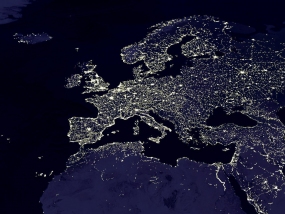Cancer survival rates in Europe continue to increase
EUROCARE-5, the largest European study on cancer survival, delivers an important indicator for the quality of health care systems. The study was carried out with a major participation of scientists from the German Cancer Research Center (DKFZ). Patients across Europe survive longer after a cancer diagnosis than they did five years ago. However, there are significant variations. The results for Germany are in the top group. In general, survival rates are highest in northern, central and southern Europe, while cancer patients in eastern Europe succumb earlier to their conditions.
EUROCARE-5 is a project of gigantic dimensions that has studied the survival of ten million cancer patients in 29 European countries. The study includes cancer cases that were diagnosed between 2000 and 2007 and deaths that were recorded until 2008. Data were provided by 209 participating European cancer registries. EUROCARE-5 covers 50 percent of the adult population and 77 percent of children in Europe.
“EUROCARE-5 documents whether, how and, above all, where advances in cancer medicine reach the population in Europe,” says Professor Hermann Brenner of the German Cancer Research Center (Deutsches Krebsforschungszentrum, DKFZ). “A population-based study of cancer survival rates does not reflect individual results of top-level medicine but instead captures the overall performance of national health care systems.” Brenner, an epidemiologist, contributes methodological know-how to this enormous project. Scientists in his department developed the mathematical data collection methods used in the project. The study was led and coordinated by the Instituto Superiore di Sanità in Italy.
There are major differences in five-year survival rates between organs affected by cancer. For cancers of the testicles, thyroid, prostate and breast, melanomas and Hodgkin lymphomas, five-year survival after diagnosis was over 80 percent. By contrast, less than 15 percent of patients with cancers of the lung, liver, pancreas and esophagus were still alive five years after diagnosis.
The study also identified differences in cancer survival between individual countries and regions. People in northern, central and southern Europe survived longer, while cancer patients in eastern Europe (Bulgaria, Slovakia, Poland and Baltic states) succumbed sooner to their conditions. Survival rates in Great Britain and Ireland represented the average. Results from Germany reached the top group for almost all types of cancer. For children with cancer, five-year survival is also higher in Germany than the European average (81 vs. 78 percent).
On the whole, survival rates across Europe have improved in the past five years since the last study for almost all body systems affected by cancer. The researchers noted the highest increases for rectal cancer and for non-Hodgkin lymphomas.
Causes of differences in survival rates
Variations in cancer survival generally reflect the availability of financial resources for public health care. This link is particularly obvious for countries in eastern Europe. Most notably, survival rates for children with cancer and for lymphoma patients are dramatically lower – a strong indicator of a shortage in the availability of effective anticancer drugs.
However, there are also marked differences between countries with comparable health care budgets. For individual cancer types, such as non-Hodgkin lymphoma or rectal cancer, this may be caused by the fact that new, improved treatments are not yet common in all countries. Differences in socio-economic conditions as well as lifestyle factors such as smoking or obesity may also have an impact on survival rates. Differences in cancer screening programs also play a role.
“Although this Europe-wide study identifies positive trends, it also shows that there is still a large potential to further improve cancer survival rates,” Brenner says. “Improving medical supply structures as well as cancer screening programs are major steps towards this aim.”
Roberta De Angelis et al.: Cancer survival in Europe in the first decade of the 21st century: results of the EUROCARE-5 study. The Lancet Oncology 2013, DOI:10.1016/S1470-2045(13)70546-1
Gemma Gatta et al.: Childhood Cancer Survival in Europe at the Beginning of the New Millennium: results of the EUROCARE-5 population-based study. The Lancet Oncology 2013, DOI: 10.1016/S1470-2045(13)70548-5
With more than 3,000 employees, the German Cancer Research Center (Deutsches Krebsforschungszentrum, DKFZ) is Germany’s largest biomedical research institute. DKFZ scientists identify cancer risk factors, investigate how cancer progresses and develop new cancer prevention strategies. They are also developing new methods to diagnose tumors more precisely and treat cancer patients more successfully. The DKFZ's Cancer Information Service (KID) provides patients, interested citizens and experts with individual answers to questions relating to cancer.
To transfer promising approaches from cancer research to the clinic and thus improve the prognosis of cancer patients, the DKFZ cooperates with excellent research institutions and university hospitals throughout Germany:
The DKFZ is 90 percent financed by the Federal Ministry of Education and Research and 10 percent by the state of Baden-Württemberg. The DKFZ is a member of the Helmholtz Association of German Research Centers.


